
Magnetic Properties
ØMagnetic field is a force which is generated due to energy change in a volume of space.
ØA magnetic field is produced by an electrical charge in motion e.g. current flowing in a conductor, orbital movement and spin of electrons.
ØThe magnetic field can be described by imaginary lines as shown in the figure below for a magnet and a current loop.
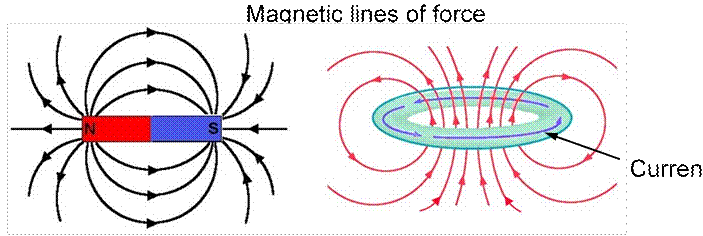
ØIf a magnetic field, H, is generated by a cylindrical coil
(solenoid) of n turns and length l, H = nI/l (A/m)
ØMagnetic flux density, B: It is the magnitude of the field strength within a substance subjected to a field H B = H (Tesla or Weber/m2)
Ø, called the permeability, is the measure of the degree to which a material can be magnetized.
ØIn
vacuum B = oH. o is the
permeability of vacuum and is a universal constant. o = 4 x 10-7(H/m).
r = /o is the relative
permeability. 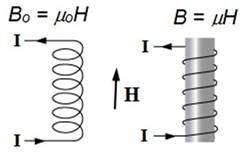
Ø Being a moving charge, electrons produce a small magnetic field having a magnetic moment along the axis of rotation.
ØThe spin of electrons also produces a magnetic moment along the spin axis.
ØMagnetism in a material arises due to alignment of magnetic moments.
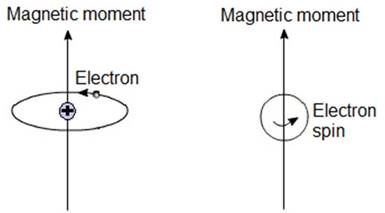
ØAnalogous to electric dipole, a magnetic dipole can be defined as two monopoles of opposite and equal strength separated by a certain distance.
ØA magnetic monopole, however, is not observed in nature.
![]()
![]() ØIf
there are N monopoles each located at a point given by a vector ā,
then the magnetic dipole moment can be defined as a vector, ū N u mai i
ØIf
there are N monopoles each located at a point given by a vector ā,
then the magnetic dipole moment can be defined as a vector, ū N u mai i
i1
ØTwo monopoles of strength +m and –m separated by distance l, will give a dipole ū = mā1 – mā2 = m(ā1 – ā2) = mĪ
ØA bar magnet can be thought of consisting of two opposite and equal poles at its two ends.
Ø With the application of a magnetic field magnetic moments in a material tend to align and thus increase the magnitude of the field strength.
ØThis increase is given by the parameter called magnetization, M, such that B = oH + oM.
M = mH.
m is called magnetic susceptibility.
m = r – 1
Ø Depending on the existence and alignment of magnetic moments with or without application of magnetic field, three types of magnetism can be defined.

Ø Diamagnetism is a weak form of magnetism which arises only when an external field is applied.
ØIt arises due to change in the orbital motion of electrons on application of a magnetic field.
ØThere is no magnetic dipoles in the absence of a magnetic field and when a magnetic field is applied the dipole moments are aligned opposite to field direction.
ØThe magnetic susceptibility, m (r – 1) is negative i.e. B in a diamagnetic material is less than that of vacuum.
H =0 H
 Diamagnetic materials:
Diamagnetic materials:
Al2O3, Cu, Au, Si, Zn
Ø In a paramagnetic material the cancellation of magnetic moments between electron pairs is incomplete and hence magnetic moments exist without any external magnetic field.
ØHowever, the magnetic moments are randomly aligned and hence no net magnetization without any external field.
ØWhen a magnetic field is applied all the dipole moments are aligned in the direction of the field.
ØThe magnetic susceptibility is small but positive. i.e. B in a paramagnetic material is slightly greater than that of vacuum.
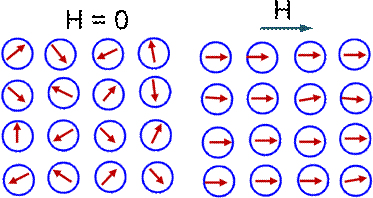 Paramagnetic materials: Al, Cr, Mo, Ti, Zr
Paramagnetic materials: Al, Cr, Mo, Ti, Zr
Ø Certain materials posses permanent magnetic moments in the absence of an external magnetic field. This is known as ferromagnetism.
ØPermanent magnetic moments in ferromagnetic materials arise due to uncancelled electron spins by virtue of their electron structure.
ØThe coupling interactions of electron spins of adjacent atoms cause alignment of moments with one another.
ØThe origin of this coupling is attributed to the electron structure. Ferromagnetic materials like Fe (26 – [Ar] 4s23d6) have incompletely filled d orbitals and hence unpaired electron spins.
Ø If the coupling of electron spins results in anti parallel alignment then spins will cancel each other and no net magnetic moment will arise.
ØThis is known as antiferromagnetism. MnO is one such example.
ØIn MnO, O2- ions have no net magnetic moments and the spin moments of Mn2+ ions are aligned anti parallel to each other in adjacent atoms.
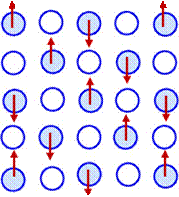
![]() O2
O2![]() Mn2+
Mn2+
Ø Certain ionic solids having a general formula MFe2O4, where
M is any metal, show permanent magnetism, termed ferrimagnetism, due to partial cancellation of spin moments.
ØIn Fe3O4, Fe ions can exist in both 2+ and 3+ states as Fe2+O2– (Fe3+)2(O2-)3 in 1:2 ratio. The antiparallel coupling between Fe3+ (Half in A sites and half in B) moments cancels each other. Fe2+ moments are aligned in same direction and result in a net magnetic moment.
|
|
|
ØFerromagnetic materials exhibit small-volume regions in which magnetic moments are aligned in the same directions. These regions are called domains.
ØAdjacent domains are separated by domain boundaries. The direction of magnetization changes across the boundaries.
ØThe magnitude of magnetization in the material is vector sum of magnetization of all the domains.
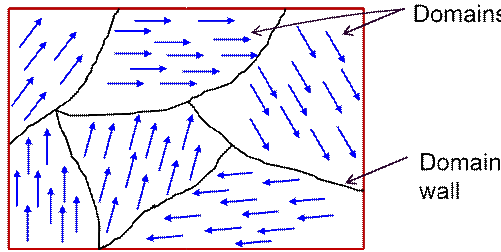
ØWhen a magnetic field is applied to a ferromagnetic material, domains tend to align in the direction of the field by domain boundary movement and hence, the flux density or magnetization increases.
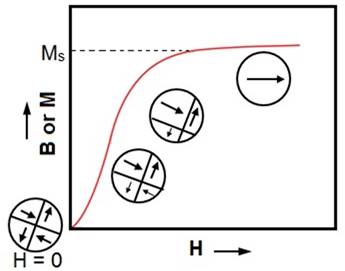 ØAs the field strength increases
domains which are favorably oriented to field direction grow at the expense of
the unfavorably oriented ones. All the domains are aligned to the field
direction at high field strengths and the material reaches the saturation
magnetization, Ms.
ØAs the field strength increases
domains which are favorably oriented to field direction grow at the expense of
the unfavorably oriented ones. All the domains are aligned to the field
direction at high field strengths and the material reaches the saturation
magnetization, Ms.
The initial slope of the B-H curve at H =0 is called initial permeability, i, which is a material property.
ØIf the field is reduced from saturation by magnetic reversal, a hysteresis develops.
ØAs the field is reversed the favorably oriented domains tend to align in the new direction. When H reaches zero some of the domains still remain aligned in the previous direction giving rise to a residual magnetization called remanence, Mr.
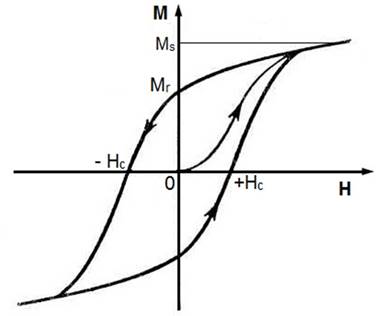 Hc, the reverse filed strength at which
magnetization is zero, is called Coercivity
Hc, the reverse filed strength at which
magnetization is zero, is called Coercivity
ØBased on their hysteresis characteristics ferro and ferrimagnetic materials can be classified as hard and soft magnets.
Ø Soft magnets have a narrow hysteresis curve and high initial permeability and hence easy to magnetize and demagnetize. It is just opposite for the Hard magnets.
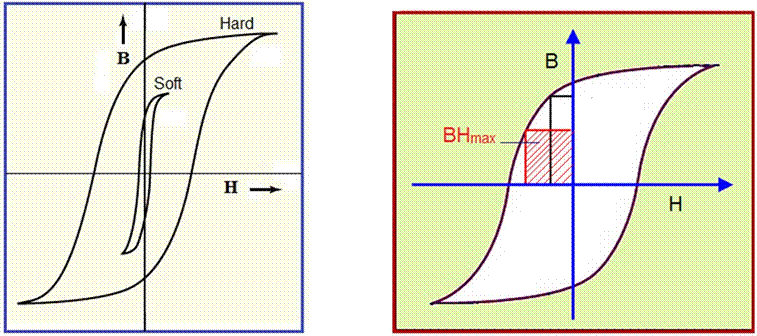
ØThe magnetic hardness is expresses by a term called energy product which is the area of the largest rectangle that can be drawn in the second quadrant (red-hatched).
ØConventional hard magnetic materials like steel, Cunife(CuNi-Fe) alloys, Alnico (Al-Ni-Co) alloy have BHmax values in the range of 2 – 80 kJ/m3. High-energy hard magnetic materials like Nd2Fe14B, SmCo5 exhibit BHmax 80 kJ/m3. ØHard magnets are used in all permanent magnets in applications such as power drills, motors, speakers.
ØSoft magnets like Fe, Fe-Si are useful when rapid magnetization and demagnetization is required as in transformer cores.
ØImpurity and other defects should be low for this purpose as they may hinder the domain wall movement through which domains align.
ØThe magnetic properties of a crystalline material are not isotropic i.e. properties are not the same in all crystallographic direction.
ØThere always happens to be a preferred direction in which magnetization is easier. For example, [0001] direction is the preferred magnetization direction in Co. For Fe it is [100] as shown in the diagrams below.

ØThe atomic vibration increases with increasing temperature and this leads to misalignment of magnetic moments. Above a certain temperature all the moments are misaligned and the magnetism is lost. This temperature is known as Curie temperature, Tc.
ØFerro and ferrimagnetic materials turn paramagnetic above curie point. For Fe Tc = 768 C, Co – 1120 C, Ni – 335 C.
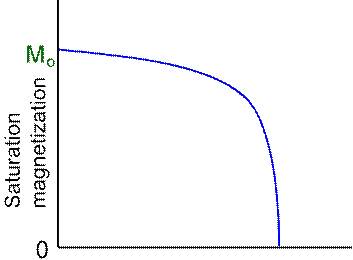
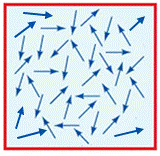
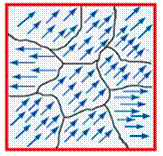 Below Tc Above
Tc Temperature Tc
Below Tc Above
Tc Temperature Tc
ØSuperconductivity is disappearance of electrical resistance below a certain temperature.
ØThe temperature below which superconductivity is attained is known as the critical temperature, TC.
ØThe superconducting behavior is represented in a graphical form in the figure below.

Ø John Bardeen, Leon Cooper and John Schreiffer – BCS theory, Noble prize for Physics in 1972 .
ØThe temperature dependence of metals arises out of scattering of electrons due to atomic vibrations which increase with temperature.
ØCooper pair – Below TC two electrons can pair through the lattice phonon which causes a slight increase in the positive charge around an electron and since thermal energy to scatter is low, this pair can move through the lattice.
Motion of Cooper pair through the lattice
BCS Theory contd..
Ø Thus the charge carrier in a superconductor is a pair of electrons instead of a single electron.
ØBCS theory applies well to conventional superconductors like Al (TC = 1.18 K), Nb3Ge (TC = 23 K).
ØHigh temp. superconductors – Recently a number of ceramic superconductors such as YBa2Cu3O7 have been discovered whose TC is much higher.
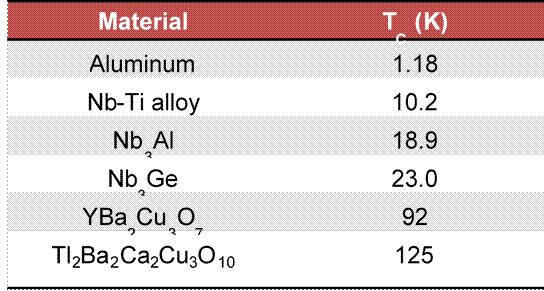
The Meissner effect
ØA material in its superconducting state will expell all of an applied magnetic field (Fig. b). This is Meisnner effect.
ØA magnet placed over a superconductor will thus float, a phenomenon known as magnetic levitation.

(a) T>TC (b) T<TC
Messner effect. (a) Above TC , normal conducting state, magnetic flux penetrates. (b) below TC, superconducting, the magnetic field is expelled.
ØIf the field is increased, some of the superconducting materials come back to normal conducting state above a critical magnetic field HC (Fig. c) – These are Type I superconductors. Ex. Al , Pb
ØIn another class of materials the field begins to intrude above a critical value of the applied field (HC1) and at a higher field (HC2) it turns into a normal conductor (Fig. d). The transition is gradual here unlike Type I. These are called Type II superconductors.
Ex. Nb3Sn, YBa2Cu3O7

Superconductors are used in
qMaglev trains which can reach very high velocity
qMRI scan machines (Medical science, Brain imaging)
qHigh efficiency electric generators
qEnergy storage
qSuperconducting Quantum Interference Device (SQUID)
qThe Large Hadron Collider (LHC) for generating high velocity particles travelling at speed of light
Magnetism; Magnetic properties; Diamagnetism;
Paramagnetism; Ferromagnetism; Ferrimagnetism; Antiferromagnetism; Hysteresis; Soft and Hard magnets; Curie point; Superconductivity; BCS theory; Meissner effect.
References
http://www.ndted.org/EducationResources/HighSchool/Magneti sm/magnetismintro.htm
http://www.ee.ucla.edu/~jjudy/classes/magnetics/
http://media.wiley.com/product_data/excerpt/22/07803103/0780
310322.pdf
http://phy.ntnu.edu.tw/~changmc/Teach/SS/SS_note/chap11.pdf http://teachers.web.cern.ch/teachers/archiv/HST2001/accelerat ors/superconductivity/superconductivity.htm http://katzgraber.org/teaching/SS07/files/burgener.pdf http://chabanoiscedric.tripod.com/NSCHSS.PDF
1. What is a magnetic field?
2. What is the source of a magnetic field?
3. What is magnetic flux?
4. What is permeability?
5. What is relative permeability?
6. What is the origin of magnetic moments in materials?
7. What are the different kinds of magnetism?
8. How is electron configuration related to magnetism?9. What is ferrimagnetism? How is it different from ferromagnetism?
10. Explain the origin of ferrimagnetism taking the example of
Fe3O4
11. What is antiferromagnetism?
12. What is a magnetic domain?
13. What is magnetic susceptibility?
14. Why do ferromagnets reach saturation on application of a magnetic field of sufficient strength?
15. Why does a residual magnetism remains even at H = 0 during magnetic reversal in ferromagnets?
16. What is Coercevity?
17. What is meant by hard and soft magnets?
18. Which parameter decides the magnetic hardness?
19. Give examples of soft and hard magnets.
20. What is initial permeability? How is it related to magnetization?
21. Why should soft magnets for transformer core application be free of defects and impurities?
22. Why the magnetism is lost when ferromagnets are heated above a certain temperature?
23. What is magnetic anisotropy? What are hard and soft axis of magnetization?
24. What is superconductivity?
25. What is BCS theory of superconductivity?
26. What is High-temperature superconductor?
27. What is Meissner effect?
28. What is Type I and Type II superconductors?
Материалы на данной страницы взяты из открытых источников либо размещены пользователем в соответствии с договором-офертой сайта. Вы можете сообщить о нарушении.